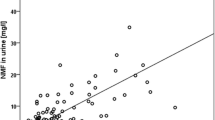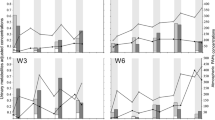Abstract
Up to date, information on the validity of human biomonitoring (HBM) parameters of naphthalene exposure is poor. This study was performed to reveal the relation between occupational exposure to naphthalene and biological exposure markers. Therefore, ten lowly and highly exposed workers from the abrasives industry were selected to characterise a broad exposure range. Naphthalene in air was determined by personal air monitoring during one shift. For biological monitoring, pre- and post-shift urine samples collected on 2 days of a working week were analysed for 1,2-dihydroxynaphthalene (1,2-DHN), 1- and 2-naphthol, 1- and 2-naphthylmercapturic acid (NMA). The naphthalene concentration in air was in the range of 0.5 to 11.6 mg/m3. The biomarkers in urine showed post-shift concentration in the range of 114–51,809 µg/L for 1,2-DHN, 0.8–666 µg/L for 1–NMA, 2–2698 µg/L for 1-naphthol and 4–1135 µg/L for 2-naphthol, respectively. 2-NMA was not detected. The urinary levels increased significantly from pre- to post-shift for all analysed parameters and an accumulation over the working week was observed. Significant positive correlations were observed between 1,2-DHN, 1-NMA, 1- and 2-naphthol in post-shift urine samples and personal exposure to naphthalene in the air. 1-NMA and 1,2-DHN, 1- and 2-naphthol have been demonstrated as suitable biomarkers for naphthalene exposure monitoring. Of the determined biomarkers, 1,2-DHN is by far the metabolite with the highest concentration in the urine samples.




Similar content being viewed by others
References
ACGIH (2016) The American Conference of Governmental Industrial Hygienists, TLVs and BEIs based on the Threshold Limit Values for Chemical Substances and Physical Agents & Biological Exposure Indices. Signature Publications, New York
AGS (2018) Ausschuss für Gefahrstoffe (Committee on Hazardous Substances): AGW-Begründung zu Naphthalin (CAS-Nr 91-20-3) (in German language)
Bailey LA, Nascarella MA, Kerper LE, Rhomberg LR (2016) Hypothesis-based weight-of-evidence evaluation and risk assessment for naphthalene carcinogenesis. Crit Rev Toxicol 46(1):1–42. https://doi.org/10.3109/10408444.2015.1061477
Barr DB, Wilder LC, Caudill SP, Gonzalez AJ, Needham LL, Pirkle JL (2005) Urinary creatinine concentrations in the US population: implications for urinary biologic monitoring measurements. Environ Health Persp 113(2):192–200. https://doi.org/10.1289/ehp.7337
Bieniek G (1997) Urinary naphthols as an indicator of exposure to naphthalene. Scand J Work Environ Health 23(6):414–420
Bieniek G (1998) Aromatic and polycyclic hydrocarbons in air and their urinary metabolites in coke plant workers. Am J Ind Med 34(5):445–454
Breuer D, Dragan GC, Friedrich C, Mohlmann C, Zimmermann R (2015) Development and field testing of a miniaturized sampling system for simultaneous sampling of vapours and droplets. Environ Sci-Proc Imp 17(2):278–287. https://doi.org/10.1039/c4em00602j
Clewell HJ, Efremenko A, Campbell JL, Dodd DE, Thomas RS (2014) Transcriptional responses in the rat nasal epithelium following subchronic inhalation of naphthalene vapor. Toxicol Appl Pharmacol 280(1):78–85. https://doi.org/10.1016/j.taap.2014.06.015
DECOS (2012) Naphthalene. Evaluation of the carcinogenicity and genotoxicity. Subcommittee on the Classification of Carcinogenic Substances of the Dutch Expert Committee on Occupational Safety (DECOS), the Health Council of the Netherlands
DFG (2018) List of MAK and BAT values 2018. Commision for the Investigation of Health Hazards of Chemical Compounds in the Work Area. https://onlinelibrary.wiley.com/page/book/10.1002/3527600418/homepage/access_to_the_list_of_mak_and_bat_values.htm. Wiley-VCH, Weinheim
Drexler H, Hartwig A, MAK Commission (2018) Naphthalene [BAT value documentation]. MAK Coll Occup Health Saf 3:2. https://doi.org/10.1002/3527600418.bb9120e2218
Göen T, Schaller KH, Drexler H (2012) External quality assessment of human biomonitoring in the range of environmental exposure levels. Int J Hyg Environ Health 215(2):229–232. https://doi.org/10.1016/j.ijheh.2011.08.012
Greim H (1998) Naphthalene. MAK value documentation. The MAK collection for occupational health and safety; http://onlinelibrary.wiley.com/doi/10.1002/3527600418.mb9120e0011/full
Greim H (2012) Addendum to naphthalene. MAK value documentation. The MAK collection for occupational health and safety; https://onlinelibrary.wiley.com/doi/full/10.1002/3527600418.mb9120e0027
Hahn JU, Assenmacher-Maiworn H (2003) Polycyclic aromatic hydrocarbons (PAH). In: Analyses of hazardous substances in air, vol 8. published by the Deutsche Forschungsgemeinschaft, Wiley-VCH, Weinheim, pp 201–228
International Agency for Research on Cancer (2002) IARC monographs on the evaluation of carcinogenic risks to humans: some traditional herbal medicines, some mycotoxins, naphthalene and styrene. Summary of data reported and evaluation IARC monographs on the evaluation of carcinogenic risks to humans: some traditional herbal medicines, some mycotoxins, naphthalene and styrene summary of data reported and evaluation. vol 82. IARC, Lyon
Jeffery AM, Jerina DM (1975) Letter: Novel rearrangements during dehydration of nucleophile adducts of arene oxides. A reappraisal of premercapturic acid structures. J Am Chem Soc 97(15):4427–4428
Klotz K, Schindler BK, Angerer J (2011) 1,2-dihydroxynaphthalene as biomarker for a naphthalene exposure in humans. Int J Hyg Environ Health 214(2):110–114. https://doi.org/10.1016/j.ijheh.2010.11.003
Klotz K, Zobel M, Schäferhenrich A, Hebisch R, Drexler H, Göen T (2018) Suitability of several naphthalene metabolites for their application in biomonitoring studies. Toxicol Lett 298:91–98. https://doi.org/10.1016/j.toxlet.2018.07.008
Kuusimäki L, Peltonen Y, Mutanen P, Peltonen K, Savela K (2004) Urinary hydroxy-metabolites of naphthalene, phenanthrene and pyrene as markers of exposure to diesel exhaust. Int Arch Occup Environ Health 77(1):23–30
Lafontaine M, Gendre C, Delsaut P, Simon P (2004) Urinary 3-hydroxybenzo[a]pyrene as a biomarker of exposure to polycyclic aromatic hydrocarbons: an approach for determining a biological limit value. Polycycl Aromat Comp 24(4–5):441–450. https://doi.org/10.1080/10406630490471447
Larsen K (1972) Creatinine assay by a reaction-kinetic principle. Clin Chim Acta 41(1):209. https://doi.org/10.1016/0009-8981(72)90513-X
NTP (1992) Technical report on the toxicology and carcinogenesis studies of naphthalene (CAS No. 91-20-3) in B6C3F1 mice (inhalation study). National Toxicology Program, Research Triangle Park, NC
NTP (2000) Technical report on the toxicology and carcinogenesis studies of naphthalene (CAS No. 91-20-3) in F344//N rats (inhalation study). National Toxicology Program, Research Triangle Park, NC
Preuss R, Drexler H, Böttcher M, Wilhelm M, Brüning T, Angerer J (2005) Current external and internal exposure to naphthalene of workers occupationally exposed to polycyclic aromatic hydrocarbons in different industries. Int Arch Occup Environ Health 78(5):355–362
Rappaport SM, Waidyanatha S, Serdar B (2004) Naphthalene and its biomarkers as measures of occupational exposure to polycyclic aromatic hydrocarbons. J Environ Monit 6(5):413–416
SCOEL (2010) Recommendation from the Scientific Committee on Occupational Exposure Limits for naphthalene SCOEL/SUM/90
Serdar B, Egeghy PP, Gibson R, Rappaport SM (2004) Dose-dependent production of urinary naphthols among workers exposed to jet fuel (JP-8). Am J Ind Med 46(3):234–244
Smith KW, Proctor SP, Ozonoff AL, McClean MD (2012) Urinary biomarkers of occupational jet fuel exposure among air force personnel. J Expo Sci Environ Epidemiol 22(1):35–45. https://doi.org/10.1038/jes.2011.38
Sucker K, Zschiesche W, Hummel T et al (2017) Naphthalene: chronic exposure at the workplace-relevance to the setting of limit values-results of a cross-sectional study into naphthalene exposure in the abrasives industry. Gefahrstoffe-Reinhaltung der Luft 77:439–442 (in German language)
TRGS 900 (2018) Technische Regeln für Gefahrstoffe, Arbeitsplatzgrenzwerte, Ausgabe Januar 2006 BArBl Heft 1/2006 S. 41-55 geändert und ergänzt: GMBl 2018 S.542-545[Nr.28] (Fassung vom 07.06.2018). Gemeinsames Ministerialblatt (GMBl) 542-545
Weiss T, Breuer D, Bury D et al (2019) (Mono-) Exposure to naphthalene in the abrasive industry—air monitoring and biological monitoring. Arch Toxicol (submitted)
Ziener C-E (2012) Biomonitoring bei Naphthalinexponierten - ein Anwendungsbeispiel (in German language). Zbl Arbeitsmed 62:159–161
Zobel M, Göen T, Belov V, Klotz K (2017) Reliable quantification of 1,2-dihydroxynaphthalene in urine using a conjugated reference compound for calibration. Anal Bioanal Chem 409(29):6861–6872. https://doi.org/10.1007/s00216-017-0651-9
Zobel M, Klotz K, Göen T (2018) LC-MS/MS procedure for the simultaneous determination of N-acetyl-S-(1-naphthyl)cysteine and N-acetyl-S-(2-napthyl)cysteine in human urine. J Chromatogr B 1074–1075:139–145. https://doi.org/10.1016/j.jchromb.2017.12.023
Acknowledgement
The Institute of Occupational, Social and Environmental Medicine of the University of Erlangen-Nuremberg contributed to the study without any financial funding. Funding for sampling and air monitoring of this study was provided by the Federation of European Producers of Abrasives (FEPA) and the German Social Accident Insurance Institutions for the administrative sector (VBG) and the energy, textile, electrical and media products sectors (BG ETEM). The scientific opinions and conclusions expressed in the paper are exclusively those of the authors and are independent of the sources of financial support. The study was approved by the local ethics committee of the Ruhr Universität Bochum (Re.-No. 5013-14, 16.05.2014). All procedures performed in studies involving human participants were in accordance with the ethical standards of the institutional research committee and with the 1964 Helsinki declaration and its later amendments or comparable ethical standards. Informed consent was obtained from all sample donors and they provided their urine voluntarily. No identifying information is included in this article.
Author information
Authors and Affiliations
Corresponding author
Ethics declarations
Conflict of interest
The authors declare that they have no competing interests.
Additional information
Publisher's Note
Springer Nature remains neutral with regard to jurisdictional claims in published maps and institutional affiliations.
Electronic supplementary material
Below is the link to the electronic supplementary material.
Rights and permissions
About this article
Cite this article
Klotz, K., Weiß, T., Zobel, M. et al. Validity of different biomonitoring parameters in human urine for the assessment of occupational exposure to naphthalene. Arch Toxicol 93, 2185–2195 (2019). https://doi.org/10.1007/s00204-019-02468-9
Received:
Accepted:
Published:
Issue Date:
DOI: https://doi.org/10.1007/s00204-019-02468-9




